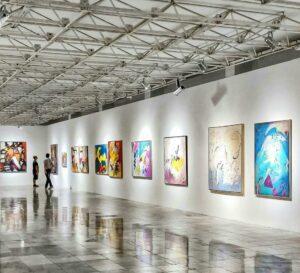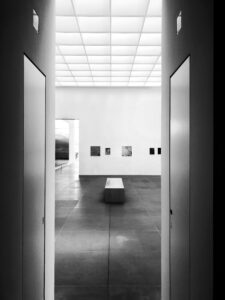
As much as we face fast pace change in many industries, also the landscape of the artworld is constantly evolving. The need for social and cultural change within galleries and museums has become increasingly apparent. Traditional structures often inhibit creativity and collaboration, prompting a call for a cultural shift.
To my opinion, there are many solutions to foster this change and I would like to highlight a few that will already make a remarkable change: flat hierarchies, agile mindsets, and appreciative communication will transform art spaces into more inclusive and dynamic environments.
1. Breaking Down Hierarchical Barriers
Historically, art institutions have been characterized by rigid hierarchies, with decisions flowing from the top down. However, the modern art world calls for a departure from this conventional model.
Implementing flat hierarchies encourages a more egalitarian approach, where ideas and contributions are valued regardless of one’s position. This shift fosters a sense of empowerment among team members, providing them with the freedom to express their creativity and contribute to the overall vision of the institution.
Breaking away from traditional hierarchical structures, artist collectives and cooperative galleries exemplify the principles of flat hierarchy. In such organizations, decision-making is decentralized, and all members have an equal say. For instance, a cooperative gallery might be managed collectively by a group of artists who share responsibilities in organizing exhibitions, marketing, and administrative tasks. This flat hierarchy encourages a sense of shared ownership and creative autonomy.
Check out the “Spaces Corners” project, a collaboration between Spaces Corners, a non-profit photobook collective, and the Carnegie Museum of Art in Pittsburgh, Pennsylvania.
Also check out flat hierarchiy organisational models from the business world such as the Holacracy Model and Collaborative Leadership.
2. Embracing an Agile Mindset
The fast-paced nature of the contemporary art scene asks for adaptability and flexibility. Adopting an agile mindset allows art galleries to respond swiftly to changing trends, audience preferences, and societal developments. This approach encourages experimentation, risk-taking, and iterative processes. By breaking away from rigid planning and embracing a more dynamic strategy, institutions can stay relevant and engage with their audience in meaningful ways.
How this might work?
Having the leader(s) of your organisation on board for a cultural shift (which it is) is crucial. Leadership should understand the benefits of agility in responding to market changes and fostering creativity
Break down silos and encourage collaboration across different departments and teams.
Move away from rigid, long-term planning towards iterative and flexible planning. Adopt agile project management methodologies, such as Scrum or Kanban, to allow for adaptability and continuous improvement.
Promote open and frequent communication channels. Regular check-ins, stand-up meetings, and feedback sessions can help keep everyone informed and aligned with organizational goals.
Encourage a culture of empowerment and autonomy. Allow team members to take ownership of their work and decision-making processes.
Emphasize a customer-centric mindset. In the art world, the “customer” may be the audience, artists, or collaborators. Understand their needs, gather feedback, and adjust strategies accordingly.
Cultivate a mindset that embraces change. In the art market, adaptability is key as trends, and market dynamics can shift swiftly. Equip the team with the skills to navigate uncertainty and respond proactively to changes in the industry.
Recognize and celebrate achievements, both big and small.
3. Encourage an Appreciative Communication
Communication is the lifeblood of any organization, and in the art world, it plays a pivotal role in shaping the narrative and fostering connections. Shifting towards appreciative communication involves acknowledging and valuing diverse perspectives, opinions, and contributions. Creating an environment where constructive feedback is encouraged promotes a culture of continuous improvement. This not only enhances the quality of the art presented but also nurtures a collaborative spirit among the team.
I have written an article on how to establish a culture of constructive criticism, read more here.
Conclusion
In conclusion, the transformation of art spaces requires a holistic approach that goes beyond the conventional norms. By adopting flat hierarchies, agile mindsets, and appreciative communication, art galleries can create environments that encourage creativity, foster collaboration, and connect with diverse audiences. This cultural shift is not only essential for the survival and relevance of art institutions but also paves the way for a more inclusive and dynamic future for the world of art.









